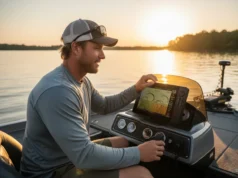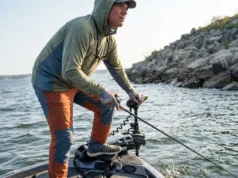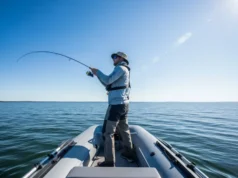In this article
There’s a quiet language spoken on the water, a conversation between the angler, the boat, and the fish. For years, we’ve learned to manage our position with a clumsy push pole, a drifting anchor, or the constant hum of a foot on the trolling motor. But technology has given us a new dialect, a way to speak with precision and purpose. The choice between a GPS-guided trolling motor like Spot-Lock and physical Shallow Water Anchors isn’t just about stopping; it’s about mastering the art of the pause, the silent hold, and the perfect position for total boat control.
Imagine you’ve spent an hour stalking a trophy bass on its bed. The water is gin clear. You make the perfect pitch, but just as the lure settles, a silent gust of wind nudges your boat forward, spooking the fish into oblivion. This single moment of frustration is the core problem that modern precision boat positioning systems were born to solve. This isn’t about dock talk or brand loyalty. This is a deep dive into the science, the data, and the real-world scenarios that will empower you to make the single most impactful gear selection decision for your angling. We’ll deconstruct the science behind virtual and physical anchoring, compare them head-to-head, and build a playbook for when to use each. By the end, you won’t just choose a piece of gear; you’ll choose the right strategy for the way you fish.
How Do These Two Anchoring Philosophies Fundamentally Work?
Before we can decide which tool is right, we have to understand how they’re made. One is a master of digital correction, a constant conversation with satellites orbiting miles above our heads. The other is a marvel of mechanical simplicity, a direct and undeniable connection to the earth below. Both achieve the same goal—holding your boat—but their methods and depth suitability couldn’t be more different.
What is the science behind a GPS virtual anchor like Spot-Lock?
Think of Spot-Lock not as a physical anchor, but as an incredibly disciplined and responsive deckhand. It’s a software-driven feature built into the brain of a GPS-enabled trolling motor like a Minn Kota Ultrex or Terrova with i-Pilot (or competing systems like the Motorguide Tour Pro). The process begins with one of several activation options: a simple button press from a foot pedal, a wireless remote, a smartphone app, or even your Humminbird fish finder. In that instant, a GPS receiver in the motor’s head records your boat’s precise geographic coordinates and saves them as a digital “GPS Anchor” point. From that moment on, the system enters a continuous feedback loop. A sophisticated algorithm constantly compares your boat’s real-time GPS position to those saved coordinates. The instant a gust of wind or a swirl of current pushes you off that mark, the system automatically engages the motor’s thrust and steering, intelligently navigating you back to the original spot.
But it’s not a static, rigid hold. The system is actually working to keep your boat within a virtual radius of about five feet from the target point, what engineers call the “Arrival Circle.” It’s a constant, subtle dance of micro-adjustments. To make this dance more graceful, a separate heading sensor—a digital compass mounted elsewhere on the boat—tells the system which way your bow is pointed. This allows for far more precise movements and unlocks the incredibly useful “Jog” feature, which lets you shift your anchor point in five-foot increments without ever disengaging the system. Of course, this digital magic, a key part of the integration with trolling motors in a system like the One-Boat Network, is only as effective as its tools; its holding power depends entirely on having a strong GPS signal and a trolling motor with enough thrust to overcome the day’s wind and current. To learn more, you can read the official U.S. government information about the Global Positioning System, the core satellite technology that makes this all possible. Understanding this feature is a critical part of choosing the best trolling motor for your vessel, where thrust and voltage are key factors.
What is the engineering behind a physical shallow water anchor?
Where Spot-Lock is a digital dance, a Shallow Water Anchor (SWA) is a statement of brute-force elegance, a modern evolution of simple Stick-It anchor pins. It is a transom-mounted device that creates a direct, physical connection between your boat and the seabed. The core of the system is a durable, flexible composite spike that, upon command, deploys and penetrates the bottom—be it mud, sand, or clay—to create an immovable hold.
There are two primary deployment method styles. The hydraulic arm style, found on industry leaders like the Power-Pole Blade and Minn Kota Raptor, features a “knuckle” that swings the spike down and away from the transom. This is contrasted with the vertical telescoping mechanism of a Minn Kota Talon, where the multi-stage spike with a set anchor spike length deploys straight down from a fixed housing. Powering these systems also comes in two flavors. Hydraulic systems use an inboard pump to push fluid through hoses, a method renowned for its quiet and powerful operation. Electro-Mechanical systems, on the other hand, use an integrated electric motor and gears, which simplifies installation. Their key value proposition is a swift, silent, and secure hold that, once deployed, requires zero power to maintain. While a single anchor creates a solid pivot point, a dual anchor setup provides a completely stationary platform that prevents swinging in wind or current. The installation of these systems requires considering cost implications and your boat’s electrical capacity, governed by regulations like the U.S. Coast Guard safety standards for marine electrical systems. It’s also important to consider how accessories impact boat performance, as the weight addition on the transom can affect the hole shot of boats like a Ranger 520R, Nitro Z20, or Bass Cat Boats.
What Does the Data Reveal in a Head-to-Head Showdown?
Now that we understand the “how,” let’s get to the “what.” This is where we move beyond marketing and into measurable performance. By translating anecdotes into verifiable numbers on holding power, stealth, and energy use, we can build a clear framework for making the right choice for your fishing style.
Boat Anchoring Systems: A Head-to-Head Comparison
GPS Virtual Anchors vs. Shallow Water Anchors
Performance Specs
Power System: Electro-Mechanical
Holding Accuracy: ~5 ft Radius
Max Amp Draw: 52 A (112lb model)
Noise Level: Variable (Prop Noise)
Key Differentiator
Total GPS integration with Humminbird fish finders for advanced boat control features like Follow-the-Contour.
Performance Specs
Power System: Electro-Mechanical
Holding Accuracy: ~5-15 ft Radius
Max Amp Draw: Not Specified
Noise Level: Variable (Prop Noise)
Key Differentiator
Sonar agnostic, meaning it can be connected to any brand of fish finder for full functionality, offering greater flexibility.
Performance Specs
Power System: Hydraulic
Transom Weight: ~31 lbs
Deployment Speed: ~1.8 fps
Est. Cost (Pair): ~$4,400
Key Differentiator
Known for being extremely lightweight, quiet (57.4 dB), and having a fast deployment speed.
Performance Specs
Power System: Hydraulic
Transom Weight: ~44 lbs
Deployment Speed: ~1.7 fps
Est. Cost (Pair): ~$4,400
Key Differentiator
Features Active Anchoring, which continuously re-drives the spike to maintain a firm hold in changing conditions like waves or current.
Performance Specs
Power System: Electro-Mechanical
Transom Weight: ~43 lbs
Deployment Speed: ~1.1 fps
Est. Cost (Pair): ~$4,400
Key Differentiator
Offers the greatest anchoring depth at up to 15 ft. The electro-mechanical design allows for a simpler installation with no hydraulic pumps.
How do they compare on holding power and accuracy?
Spot-Lock is engineered to hold a boat within a 5-foot radius of its target coordinate in optimal conditions. It’s a dynamic “station keeping” process; your boat is always in a state of controlled micro-movement. However, this accuracy is variable. In higher winds or strong current, its stability in wind/current can degrade, expanding that holding circle to 10 or even 15 feet. Its ability to hold is directly proportional to the thrust of your trolling motor—if the elements are stronger than your motor, you will lose your position.
A Shallow Water Anchor, by contrast, offers absolute, fixed boat control precision. Once that spike is set, your boat’s position relative to that point is zero. There is no drift, no wander, no “arrival circle.” If you deploy a single SWA, wind can still cause the boat to pivot or “swing” around the spike, but the transom is locked. For the ultimate in precision, a dual SWA setup completely eliminates this, allowing you to hold precisely in wind/current. To combat challenging conditions, modern SWAs even feature advanced auto bottom features like Minn Kota’s “Active Anchoring” on the Raptor, which can detect if the spike is pulled loose and will automatically re-drive it to ensure the hold remains secure.
What is the stealth profile of each system in decibels and disturbance?
Here lies one of the most critical differences for any angler who values a subtle approach and true stealth. Spot-Lock’s primary liability is the continuous noise level and water movement from its spinning propeller. This constant “prop wash” can be a significant issue in shallow water, causing sediment disturbance that can easily lead to fish spooking. For sight fishing or spawn/bed fishing, this audible and visible signature is a major disadvantage.
A modern SWA, on the other hand, is built to deploy quietly in shallows. The shallow water anchor deployment is a brief, intermittent sound. Data shows a modern hydraulic Power-Pole ONE Pump operates at an average of just 57.4 decibels—quieter than a normal conversation. Once the spike is deployed, the system is completely silent, creating zero disturbance, the essence of low-disturbance anchoring.
Pro-Tip: Many modern SWAs, like those with Power-Pole’s C-Monster system, allow you to adjust the deployment speed. On a calm day when you’re sneaking up on spooky fish, set it to the slowest, quietest speed. You’ll sacrifice a couple of seconds on deployment for an ultra-stealthy approach the fish will never detect.
This difference is about more than just not spooking a single fish. Minimizing bottom disturbance is a core principle of habitat conservation. According to NOAA Fisheries data on Essential Fish Habitat, sensitive areas like spawning beds are critical to healthy fisheries, and reducing our impact on them is a responsibility we all share. It’s a key part of minimizing stress on fish and ensuring a sustainable future for our sport.
How does power consumption differ between continuous and intermittent systems?
Your boat’s battery runtime is a finite resource, and understanding the power draw difference can be the key to a full day on the water. Spot-Lock is a continuous-draw system. From the moment you press the button, the trolling motor has a constant power consumption to maintain its position. That power draw is dynamic; on a calm day, it might be just a few amps, but in a stiff wind, a powerful 112lb thrust Minn Kota Ultrex can pull up to 52 amps at maximum thrust.
Shallow Water Anchors are intermittent-draw systems. They only consume power for the few seconds it takes to deploy or retract. A modern Power-Pole pump draws around 8.8 amps, while an electro-mechanical Talon can draw up to 30 amps or a Raptor up to 70 amps, but only for that brief moment. The crucial advantage is this: once deployed, an SWA uses zero power to hold the boat. This presents a huge “energy economy” trade-off. By using a low-draw SWA for holding, you preserve your trolling motor batteries exclusively for propulsion.
Which System Is the Right Tool for Your Specific Fishing Style?
The data tells a clear story of trade-offs. The best system depends entirely on your specific versatility across conditions and needs—whether you’re fishing shallow points/grass/wood/docks in South Louisiana or deep structure on the Great Lakes.
What is the best choice for shallow water sight fishing or dock pitching?
For these scenarios, the Shallow Water Anchor is the undisputed champion. In any situation less than 10-12 feet deep where stealth and precision are priorities, an SWA like a Power-Pole or Talon is the superior tool. The “stealth penalty” of Spot-Lock is a critical liability. Techniques like spawn/bed fishing for bass or sight fishing for redfish on the flats in North Florida demand the silent approach and fixed hold that only an SWA can provide. The 5-foot “arrival circle” of Spot-Lock is too imprecise for making repeated, pinpoint casts. A dual SWA setup provides the ultimate casting stability, allowing you to pick apart a line of docks on the Potomac River with surgical precision. The critical need for stealth is backed by research, like this Florida Fish and Wildlife Conservation Commission research on bass spawning behavior, and ties directly into employing the right tactics for pre, spawn, and post-spawn fishing.
What is the only option for deep offshore structure?
Once the depth exceeds the anchor spike length, the equation flips entirely. Here, Spot-Lock is the unequivocal winner and the only viable option for deeper water applications. The longest SWA models reach a maximum of 15 feet; beyond that, they are ineffective. Spot-Lock’s capability, on the other hand, is unlimited by depth. Its primary use case is holding precisely over offshore structure like ledges or brush piles. This capability fundamentally unlocks new ways to effectively fish deep, open-water environments. It enables repeated, precise casts and makes techniques like vertical jigging more efficient, as it holds post-hook set, letting you focus on fighting the fish instead of controlling the boat. For any angler who spends significant time in water deeper than 15 feet, a GPS trolling motor is an essential tool for targeting fish on deep structure.
Pro-Tip: When approaching a deep-water spot in wind or current, motor past your target waypoint and position your boat upwind or up-current of it. Then, engage Spot-Lock. The motor will have to work much less to simply hold its position against the elements, rather than fighting to reverse course and then hold. This saves significant battery power and creates less initial noise and disturbance.
Conclusion
The debate of Spot-Lock vs Power-Poles isn’t about which is “better,” but which is the right tool for the job. The data provides a clear verdict:
- Spot-Lock’s Domain is Versatility & Depth: It is the superior tool for fishing in water deeper than 15 feet, offering unparalleled convenience.
- SWA’s Domain is Stealth & Precision: It provides an absolute, silent hold in shallow water, making it the essential choice for sight fishing and any scenario where minimal disturbance is paramount.
- The Decision is a Strategic Calculation: The choice is driven by quantifiable trade-offs in power consumption, accuracy, and physical limitations like transom weight.
- The Ultimate Solution is Synergy: Many anglers find they need both Spot-Lock and shallow water anchors. The most competitive anglers, like Bassmaster Elite Series pro Bill Lowen, utilize both systems in tandem, creating a “total boat control” system for every conceivable scenario.
Master your vessel with our full library of boat control and marine electronics guides, and share which system you chose for your fishing style in the comments below.
FAQ – Frequently Asked Questions
Do I really need both Spot-Lock and shallow water anchors?
While not strictly necessary for all anglers, top-tier professionals consider having both systems essential for achieving “total boat control” across all depths and scenarios. Having both provides the optimal tool for any situation, from stealthy shallow presentations (SWAs) to precise deep-water holds (Spot-Lock).
If I can only afford one, which should I get first?
A trolling motor with Spot-Lock is the most versatile single option because it functions effectively in all water depths. However, if you fish almost exclusively in water less than 10 feet deep, a pair of shallow water anchors would be the more effective and specialized tool.
Which is better for bass fishing in windy conditions?
Both systems are effective, but for holding a specific spot in shallow water, a dual shallow water anchor setup provides a more rock-solid, zero-movement hold that is unaffected by the strength of the wind or current. Spot-Lock can hold in heavy conditions but will consume significantly more battery power, and its accuracy may decrease.
Can Spot-Lock completely replace a shallow water anchor like Power-Poles?
No, Spot-Lock cannot replace a shallow water anchor for applications requiring absolute stealth and zero bottom disturbance, such as sight fishing for spawning bass. The noise and prop wash from the trolling motor are significant disadvantages in shallow, clear water compared to the silent operation of an SWA.
Risk Disclaimer: Fishing, boating, and all related outdoor activities involve inherent risks that can lead to injury. The information provided on Master Fishing Mag is for educational and informational purposes only. While we strive for accuracy, the information, techniques, and advice on gear and safety are not a substitute for your own best judgment, local knowledge, and adherence to official regulations. Fishing regulations, including seasons, size limits, and species restrictions, change frequently and vary by location. Always consult the latest official regulations from your local fish and wildlife agency before heading out. Proper handling of hooks, knives, and other sharp equipment is essential for safety. Furthermore, be aware of local fish consumption advisories. By using this website, you agree that you are solely responsible for your own safety and for complying with all applicable laws. Any reliance you place on our content is strictly at your own risk. Master Fishing Mag and its authors will not be held liable for any injury, damage, or loss sustained in connection with the use of the information herein.
Affiliate Disclosure: We are a participant in the Amazon Services LLC Associates Program, an affiliate advertising program designed to provide a means for us to earn advertising fees by advertising and linking to Amazon.com. As an Amazon Associate, we earn from qualifying purchases. We also participate in other affiliate programs and may receive a commission on products purchased through our links, at no extra cost to you. Additional terms are found in the terms of service.





